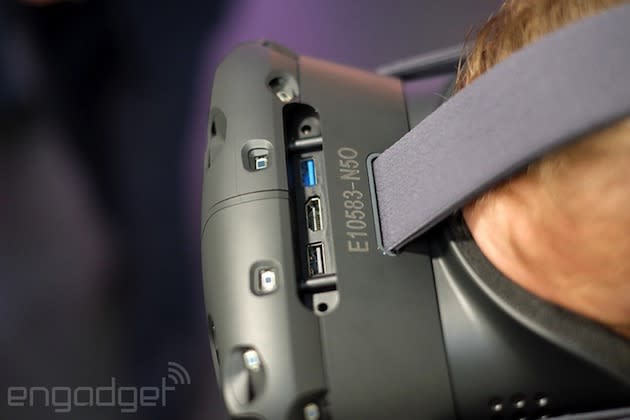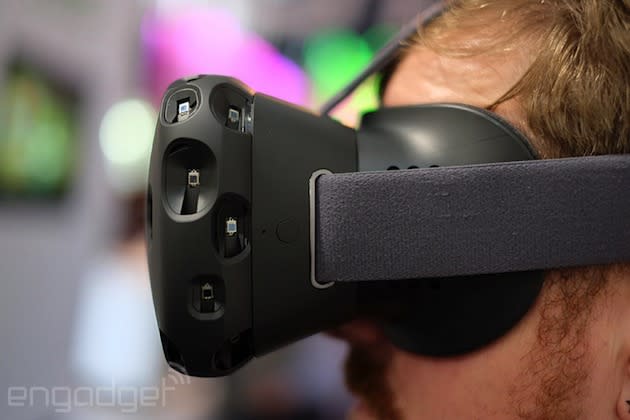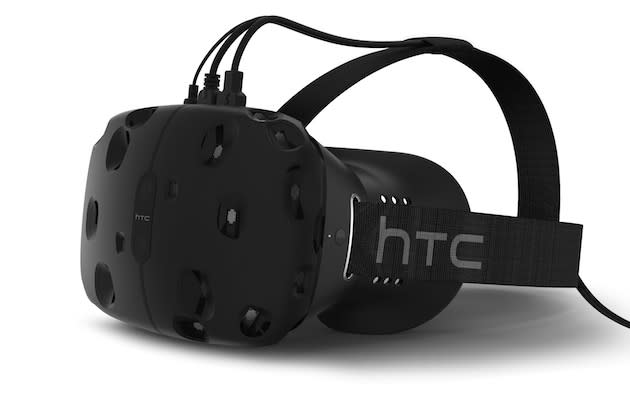HTC's Vive made me believe in VR

I am in the Matrix. Or rather, I am in that same expanse of infinite white space that was also Neo's training grounds in the movie. Hexagonal tiles appear underneath, randomly rising and falling around me. With trepidation, I step forward, slowly walking across the field of unstable tiles, trying to get a feel of this strange new land. Suddenly, I come up against a grid wall. It seems the space isn't so infinite after all. I was, of course, not in the Matrix. Instead, I was in a stark, windowless room inside the Fira Gran Via in Barcelona. On my head was the HTC Vive. And for the next 20 minutes, I was about to have a virtual reality experience unlike any I've ever had.
Before we get into that, let me tell you more about the Vive. It's a VR headset made by HTC in partnership with Valve Corporation, a company perhaps best known for the Steam PC gaming storefront and titles like Portal and Half Life 2. The hardware itself looks like something from a science fiction movie. Its dark gray, plastic faceplate is pockmarked by multiple sensors, making the whole thing look like it's clad in deep-set digital eyes. Look behind it and you'll find all the trademark signs of a VR headset: thick foam padding, a pair of goggle-like lenses and, of course, the straps that hold it all in place. It has two discrete 1,200 x 1,080 displays that refresh at 90 frames per second, offering 360-degree views. On the top of the hardware are an HDMI port, two USB ports and a headphone jack.
It's worth mentioning that the HTC Vive is not a mobile solution like the Gear VR -- it connects to a computer like the Oculus Rift. The Vive is part of HTC's "Re" line of connected devices and exists as a separate division from the company's phones. As such, the Vive is competing less against Gear VR and more against the likes of Oculus and Sony's Project Morpheus. The key difference between the Vive and the other two? It's that it comes with a couple of SteamVR base stations that tell the Vive headset where you are via laser position sensors, thus tracking your physical location as you walk about the room. The whole thing only works in a space up to 15 x 15 feet, so you'd encounter that aforementioned gridded wall if you hit the edge.

In the room where I had the demo, the two base stations were located where the ceiling meets the wall, about 90 degrees from each other. Attached to the Vive was a slew of cords; one was to a computer located at the far end of the room, while another led to a pair of controllers that look a lot like the Wii's nunchuks, except in place of joysticks, there are touchpads. The left and right sides of the grips are clickable and there's also a trigger button located where your index finger would naturally rest. A small shield of sensors that look similar to the ones on the Vive's faceplate are located in front of each controller. An HTC spokesperson tells me that the final version of the controllers should be wireless instead of wired, but for now, I had to strap on a belt full of cords as well as the Vive to prevent the headset from weighing me down.
So there I was, with a headset strapped on my face, a controller in each hand, a belt full of cords at my waist and a large pair of headphones on my head, completely blind to everything around me. I felt awkward and skeptical, completely ready to be unimpressed.
And then the software clicked into place. A welcome screen appeared, filling my field of vision. I was instantly struck by how bright and sharp everything looked. I saw the animated versions of my controllers in front of me. The HTC spokesperson instructed me to move them around and get used to the controls. He told me to hold down my left trigger button to inflate a balloon, and I did. I then used the right one to bat it away. After playing with that for a while, the scene transitioned to the Matrix-like hexagonal tile demo I mentioned earlier. This tile intro, my guide told me, is to get me used to moving around the room. My movements were a little hampered by the amount of cords that I had to walk over, but I otherwise had no problem with balance or spatial awareness. I didn't get any kind of motion sickness at all.

Next was a demo called "TheBlu:Encounter" by Wemo Lab. Everything went black. Soon, I found myself underwater, standing on the deck of a shipwreck. Schools of fish swam around me and I was able to swat them away by waving my controller-filled hands. It sounds terribly cliché, but everything was incredibly lifelike. It genuinely felt like I was there. Everything from the fish to the shipwreck was sharp and detailed. I walked around the deck, absorbing everything around me. Soon, a giant blue whale swam right next to the ship, scaring the bejeezus out of me with its presence -- I'll admit I yelped and took a step back.
I then went from the deep blue sea to a cartoon-like kitchen, where I controlled a pair of animated hands. In a demo titled "Job Simulator" by Owlchemy Labs, my task was to add a list of ingredients to the pot on the stove before time was over. Of course, instead of doing that, I explored the kitchen. I picked up the rolling pin and the mushrooms and opened the refrigerator door. The controls were responsive for the most part -- I only really used the trigger button -- though there were a couple of times when the accuracy seemed a little off and I picked up the wrong thing by mistake.
The scene changed again and then I was a giant looking over a miniaturized tabletop battle. Called "Quar" by Steel Wool, the demo showed tiny soldiers fighting a rather epic battle, with tiny men riding on tiny horses and brandishing their tiny swords. I was able to crouch down, move around and look at the detail of the miniature figures from all angles.
Then, the HTC spokesperson said, it was time to get creative. I was suddenly in a demo of "Tilt Brush," a 3D painting app that has already been around for a few months for other VR environments like on the Oculus Rift and Google's Cardboard. The difference here, however, is that you could literally use the controller as if it was a brush, painting abstract scenes of fire and light. And then when you're done, you can walk away from your creation and view another perspective of it, giving it an almost sculptural quality.

HTC and Valve saved their best demo for last. The spokesperson told me that he would keep quiet from then on and I was to follow the instructions given. As the scene faded from black, I found myself in a very familiar environment. I could feel myself smiling, grinning from ear to ear. I couldn't help myself. I was in an Aperture Science testing facility. Yes, I was inside the world of Portal.
It looked as if I was in some kind of repair room. A disembodied voice came over the speakers and told me to open a drawer. I looked around me, saw some built-in drawers and walked over to them. I opened a drawer, only to see blueprints and tools. The voice said I opened the wrong one, so I tried again. This time, I saw a moldy cake. Apparently that was the wrong one also, so I opened another one. It contained tiny, little cutout people at tiny, little office desks who went berserk at the sight of me. The disembodied voice told me that I had made a mistake and that I was now their god.
Suddenly, Atlas awakened, and lumbered toward the room. It was so imposing and realistic that I backed away instinctively from the door.
Giving up on me, the voice then told me to walk across the room and pull on a lever. I did that and a giant door opened. Behind it were two of Portal 2's androids, Atlas and P-Body, lying on the floor broken and in disrepair. Suddenly, Atlas awakened, and lumbered toward the room. It was so imposing and realistic that I backed away instinctively from the door. The voice then told me to press on a button to expand its components so that I could repair it. I did so, pulling on its front exterior to expose its electronic guts. The next thing the voice told me to do was so complicated and full of technical jargon that I knew it was impossible. The voice told me to keep calm while also warning me with increasing urgency that if I didn't accomplish the task in time, I would fail.
And, of course, I did. Atlas collapsed on the floor with great noise and fanfare; the floor gave way and the room started to fall apart around me. I was told in a deadpan manner that I was now not qualified to do anything. Then, a familiar voice popped up. It was GladOS, Portal's AI antagonist, wondering out loud how a robot could possibly fail this simple mission until a camera popped by and saw me, to which she responded, "Oh." As the room started to get rebuilt around me, she said that I had done well as far as humans go, and that I was relieved of my duties. The demo then faded out to an outro and it was over.
But I didn't want it to be. I wanted to stay in that world. I wanted to keep playing. I wanted now, very badly, to play Portal 2 in virtual reality. It was the most immersive experience, and frankly, the most fun I've had with a VR headset strapped on my head. The ability to walk around the room and directly interact with objects around me makes a huge difference. It's made me a convert to VR.

Clearly, the HTC Vive used in the demo is just a prototype. Its design simply doesn't inspire the same reverence as the company's smartphones. But that's going to change. "Our goal is to design something that can live in your house or on your nice desk," says Claude Zellweger, HTC's chief designer. "We don't want to think of it as a geeky gamer accessory."
"For me, there's a triangle of elements that make the experience: the audio, the headset and the controllers," says Zellweger, on what makes Vive so special. "It's amazing. You don't need to see your hands at all; so long as you have fully tracked controllers, you have a full sense of yourself."
Obviously, however, HTC still has some challenges. For one, all those cords make it really difficult to walk around the room without the fear of tripping and falling over. Even if the controllers will be cordless eventually, HTC says the headset itself would still probably be tethered to a PC due to latency issues with wireless connectivity. Plus, not everyone will have the room or space to hook up two laser base stations so that the Vive will work. We also have yet to know what the minimum PC requirements are for the Vive to work as smoothly as it did. If we're to guess, we'd surmise it's quite demanding.
Yet, I walked away from the demo a complete believer, not just in VR, but also in HTC and Valve, and I can't wait to see what's next. HTC has said that the developer edition of the Vive will be available later this spring, while a commercial retail version will be in stores by the end of the year. I'm not sure if I'll be able to afford this yet, but if I can? Sign me up.
Edgar Alvarez contributed to this report.
Don't miss out on all the latest news, photos and liveblogs from MWC 2015. Follow along at our events page.


















